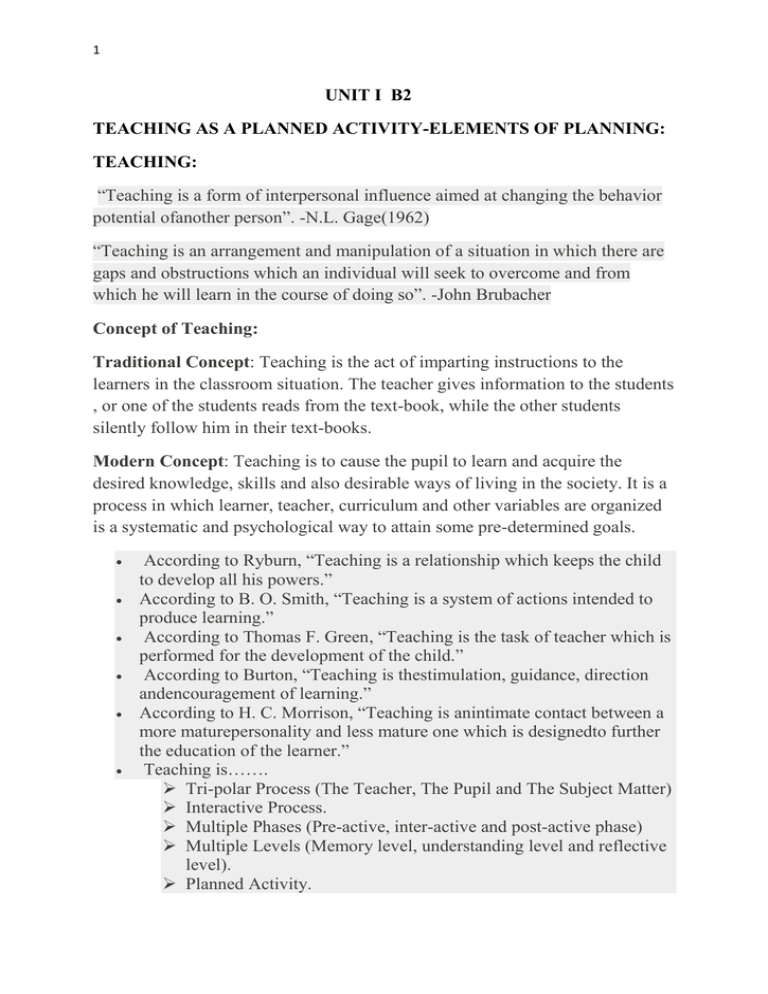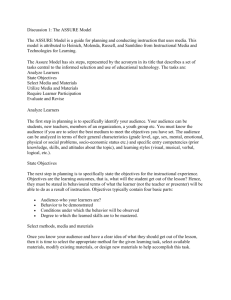Teaching AS A PLANNED ACTIVITY
advertisement

1 UNIT I B2 TEACHING AS A PLANNED ACTIVITY-ELEMENTS OF PLANNING: TEACHING: “Teaching is a form of interpersonal influence aimed at changing the behavior potential ofanother person”. -N.L. Gage(1962) “Teaching is an arrangement and manipulation of a situation in which there are gaps and obstructions which an individual will seek to overcome and from which he will learn in the course of doing so”. -John Brubacher Concept of Teaching: Traditional Concept: Teaching is the act of imparting instructions to the learners in the classroom situation. The teacher gives information to the students , or one of the students reads from the text-book, while the other students silently follow him in their text-books. Modern Concept: Teaching is to cause the pupil to learn and acquire the desired knowledge, skills and also desirable ways of living in the society. It is a process in which learner, teacher, curriculum and other variables are organized is a systematic and psychological way to attain some pre-determined goals. According to Ryburn, “Teaching is a relationship which keeps the child to develop all his powers.” According to B. O. Smith, “Teaching is a system of actions intended to produce learning.” According to Thomas F. Green, “Teaching is the task of teacher which is performed for the development of the child.” According to Burton, “Teaching is thestimulation, guidance, direction andencouragement of learning.” According to H. C. Morrison, “Teaching is anintimate contact between a more maturepersonality and less mature one which is designedto further the education of the learner.” Teaching is……. Tri-polar Process (The Teacher, The Pupil and The Subject Matter) Interactive Process. Multiple Phases (Pre-active, inter-active and post-active phase) Multiple Levels (Memory level, understanding level and reflective level). Planned Activity. 2 Intentional Behaviour. Communication between 2 or more persons. To cause motivation to learner. Guidance. Professional Activity. Art as well as Science. Nature and Characteristics of GoodTeaching: Includes the Provision of Desirable Information Is Causing to Learn Needs Efficient Planning Is Selective (Disseminating the selected knowledge is called good teaching). Is to Provide Opportunities for Activity. Is Sympathetic (Successful teaching essentially requires emotional stability and security) Is Cooperative (Teacher should offer good suggestions). Is Organization of Learning. Is Democratic. Is Progressive Leads to Emotional Stability Is Helping the … Child to Adjust Himself to his Environment Is a Means of Preparation for Future Life Is Both Diagnostic and Remedial TEACHING AS A PLANNED ACTIVITY : A key aspect of effective teaching is having a plan for what will happen in the classroom each day. Teaching and learning should be well planned with clear objectives that are understood by learners. The approaches to teaching and learning should engage all learners, encouraging them to be active partners in the process. The activities should be relevant to the needs of learners and to the programme they are following. Creating such a plan involves setting realistic goals, deciding how to incorporate course textbooks and other required materials, and developing activities that will promote learning This means that teaching learning sessions should: meet individual learning needs; contain activities that motivate and engage all learners, whatever their age, ability and cultural background; 3 make clear links between schemes of work and individual session plans; and thus a teacher who is prepared is well on his/her way to a successful instructional experience. Planning is important because how we teach is as important as what we teach. PURPOSE OF PLANNING: The purposes of planning include: clarification of the objectives to the pupils, provision for individual differences, development of means for stimulating interest, provision for a logical instructional sequence, provision for flexibility, and enabling the teacher to teach with confidence. STEPS OF PLANNING : Effective planning is the basis of successful teaching. Planning begins with the goals of a particular teaching- learning situation; encompasses means of attaining those goals, including materials and activities; and terminates with effective procedures for evaluating the degree to which the instructional goals have been achieved. Good planning has the potential to build confidence, and make a teacher feel more secure in lesson execution. TYPES OF PLANNING : Basic types of planning include: Long-range plans for the year or semester Plans of units of work relating to the larger plan and 4 Plans for each days work -- all contributing to the accomplishment of the major objectives of education. Cooperative planning. Although the preparation of actual plans is regarded as the primary responsibility of the student teacher, it must be viewed as a team effort action. Thus, the mentor teacher plays a critical role in planning for teaching. A wide range of activities may be included in the planning process, such as, the mentor teacher: serving as an exemplar of well-planned teaching; furnishing basic planning instruction; encouraging, and if necessary, insisting on planning being done; critiquing student prepared plans; recommending modifications; using the plans as a basis for objectifying observations; and helping the student evaluate his or her instructional efforts within the context of the pre-prepared plans. In other words, careful, cooperative planning involves instruction and offers the mentor teacher excellent opportunities for establishing good working relationships and guiding the growth of the student teacher. Elements of planning : statement of objectives, which clearly shows what is to be taught and the outcomes to be achieved, expressed in terms of pupil learning; statement of activities, a logical step-by-step sequence of instruction, necessary transition, and an appropriately developed ending; list of materials to be used; assessment, including at least two types of assessment: o assessment of pupil learning, and o assessment of the teaching procedures. Title of the lesson Time required to complete the lesson List of objectives which may be behavioural objectives (what the previous lessons student can do at lesson completion) or knowledge objectives (what the student knows at lesson completion) The set (or lead-in, or bridge-in) that focuses the lesson students on the lessons skills or concepts—these List of required materials include showing pictures, which or models, asking leading questions, or reviewing 5 An instructional component that describes the sequence of events that make up the lesson including the teachers instructional input and guided practice to students to try new skills or work with new ideas. An evaluation component, a test for mastery of instructed skills or, concepts—such as a set of questions to answer or a set of instructions to the follow Analysis component the teacher uses to reflect on the lesson itself — such as what worked, what needs improving A Summary where the teacher wraps up the discussion and answers questions A continuity component reviews and reflects content from the previous lesson





